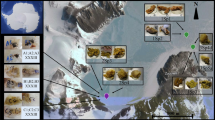Abstract
The tropical marine sponge Dysidea herbacea (Keller) contains the filamentous unicellular cyanobacterium Oscillatoria spongeliae (Schulze) Hauck as an endosymbiont, plus numerous bacteria, both intracellular and extracellular. Archaeocytes and choanocytes are the major sponge cell types present. Density gradient centrifugation of glutaraldehyde-fixed cells with Percoll as the support medium has been used to separate the cyanobacterial symbiont from the sponge cells on the basis of their differing densities. The protocol also has the advantage of separating broken from intact cells of O. spongeliae. The lighter cell preparations contain archaeocytes and choanocytes together with damaged cyanobacterial cells, whereas heavier cell preparations contain intact cyanobacterial cells, with less than 1% contamination by sponge cells. Gas chromatography/mass spectrometry analysis has revealed that the terpene spirodysin is concentrated in preparations containing archaeocytes and choanocytes, whereas nuclear magnetic resonance analysis of the symbiont cell preparations has shown that they usually contain the chlorinated diketopiperazines, dihydrodysamide C and didechlorodihydrodysamide C, which are the characteristic metabolites of the sponge/symbiont association. However, one symbiont preparation, partitioned by a second Percoll gradient, has been found to be devoid of chlorinated diketopiperazines. The capability to synthesize secondary metabolites may depend on the physiological state of the symbiont; alternatively, there may be two closely related cyanobacterial strains within the sponge tissue.
Similar content being viewed by others
Author information
Authors and Affiliations
Additional information
Received: 13 November 1997 / Accepted: 18 December 1997
Rights and permissions
About this article
Cite this article
Flowers, A., Garson, M., Webb, R. et al. Cellular origin of chlorinated diketopiperazines in the dictyoceratid sponge Dysidea herbacea (Keller). Cell Tissue Res 292, 597–607 (1998). https://doi.org/10.1007/s004410051089
Issue Date:
DOI: https://doi.org/10.1007/s004410051089




